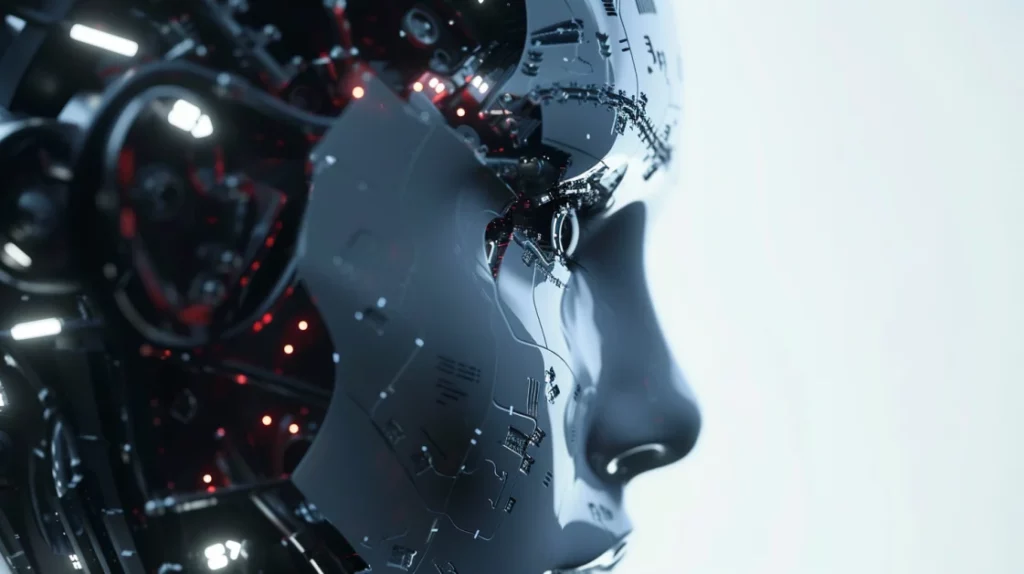
The realm of robotics is undergoing a metamorphosis, with the lines between human and machine blurring more than ever before. Researchers have achieved a groundbreaking feat: seamlessly integrating living, engineered skin tissue onto the intricate forms of humanoid robots. This heralds a new era in biohybrid robotics, a field that merges biological elements with the precision of mechanical engineering to create robots that are not only more lifelike but also vastly more functional.
Bridging the Gap: Skin Integration – A Feat of Bioengineering
Led by Professor Shoji Takeuchi at the University of Tokyo, this innovation tackles a longstanding hurdle in robotics – the seamless interface between artificial structures and living tissues. This advancement not only elevates the aesthetic appeal of humanoid robots but also unlocks a new level of functionality and interaction with the environment.
The key lies in the team’s ingenious approach to skin adhesion, inspired by the human body’s own design. Mimicking the structure of skin ligaments, they developed a method for engineered skin to effectively bond with robotic surfaces. Picture this: V-shaped indentations strategically placed on the robot’s surface act as anchor points for the skin tissue, allowing it to flawlessly conform to the robot’s complex contours. This method surpasses previous techniques that relied on bulky hooks or anchors, which limited application and risked damaging the skin during movement.
Maintaining a sterile environment to prevent bacterial contamination and manipulating delicate, wet biological materials presented significant challenges. The team’s solution? A specialized collagen gel used for adhesion. Through a process called plasma treatment, this gel was successfully coaxed into the minute perforations, creating a strong bond while safeguarding the integrity of the living tissue.
Living Skin on Robots: Unveiling a Spectrum of Advantages
The application of living skin to robots offers a multitude of advantages:
- Enhanced Dexterity and Flexibility: The natural pliability of the skin, combined with the robust adhesion method, allows it to move seamlessly with the robot’s mechanical parts, boosting overall mobility and enabling more fluid, lifelike movements.
- Self-Repair Mechanisms: Unlike synthetic materials, living skin possesses the remarkable ability to autonomously heal minor injuries. This significantly enhances the durability and longevity of robotic systems, reducing the need for frequent maintenance or replacement.
- Integrated Sensory Potential: Living skin paves the way for integrating biological sensors directly into the robot’s exterior. This translates to more sophisticated environmental awareness and improved interactive capabilities, allowing robots to respond more naturally to their surroundings.
- Uncanny Valley Conquest: By replicating the texture and structure of human skin, this technology brings robots closer to achieving a truly human-like appearance. This enhanced realism is particularly valuable in applications where human-robot interaction is crucial, potentially fostering greater acceptance and comfort in social settings.
These advancements represent a giant leap towards creating robots that not only resemble humans but also possess some of the remarkable properties of living organisms. As research progresses, we can anticipate even more groundbreaking developments that blur the lines between artificial and biological systems.
From Cosmetics Testing to Advanced Medical Training: A Glimpse into the Future
The integration of living skin with robotics has the potential to revolutionize a vast array of industries:
- Cosmetics Industry Revolution: This technology could transform product testing in the cosmetics industry. Imagine lifelike skin on robotic platforms, allowing companies to assess the effects of their products with greater accuracy and efficiency, eliminating the need for human volunteers. This approach is not only more ethical but also offers consistent and controllable testing conditions.
- The Future of Surgical Training: Robots with realistic skin could serve as invaluable training tools for plastic surgeons. These advanced models would allow surgeons to practice complex procedures in a safe and controlled environment, honing their skills without risk to human patients. The ability to replicate various skin conditions and types could provide a diverse range of training scenarios.
- Advanced “Organ-on-a-Chip” Research: Imagine a “face-on-a-chip” – a concept that expands upon current organ-on-a-chip technology. This could be a game-changer for research into skin aging, cosmetic effects, and surgical procedures. By providing a more comprehensive and realistic model of human skin, it could enable deeper insights into dermatological processes and pave the way for more effective interventions.
- Enhanced Environmental Awareness for Robots: With the potential to embed sensors within living skin, robots could achieve a new level of environmental awareness. This heightened sensing capability would lead to more nuanced and appropriate responses to their surroundings, making robots safer and more effective in various settings, from healthcare to industrial applications.
Challenges and the Road Ahead
While integrating living skin with robotics marks a significant milestone, there are still challenges to overcome:
- Achieving Hyper-Realism: Incorporating intricate details like natural wrinkles, visible pores, and varying skin tones is essential. Adding functional components such as sweat glands, sebaceous glands, and blood vessels would further enhance both appearance and physiological responses.
- Mimicking Micro-Muscles for Expressive Faces: Developing advanced “muscles” capable of producing subtle, nuanced facial movements requires a deep understanding of the intricate interplay between facial structure and skin. This delves into biomimicry and fine motor control beyond mechanical considerations.
The Future of Biohybrid Robotics
Long-term goals in biohybrid robotics center around creating robots with self-healing capabilities, human-like environmental awareness, and dexterous task performance. Achieving these objectives necessitates ongoing interdisciplinary collaboration, bringing together advancements in materials science, robotics, and biology. Additionally, researchers must address ethical considerations surrounding the development of increasingly lifelike robots and their integration into society.
A Turning Point in Robotics
The successful binding of engineered skin tissue to humanoid robots signifies a pivotal moment in robotics. This breakthrough enhances the aesthetic realism of robots and introduces functional benefits that could revolutionize various industries. The potential impact of this technology spans numerous fields, from accelerating medical training and research to transforming product testing practices. It also pushes the boundaries of human-robot interaction, potentially leading to more accepted and integrated robotic systems in social and professional settings.
As we look towards the horizon, the continued development of humanoid robotics with lifelike skin opens up a treasure trove of possibilities. By overcoming current challenges and refining their techniques, researchers may one day create robots that are indistinguishable from humans in appearance and capability. This could lead to profound changes in how we interact with and utilize robotic technology in our daily lives.
